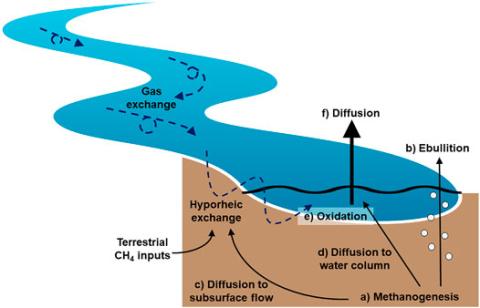
Different aquatic bodies play different roles in the release of methane gas. Wetlands, lakes, and reservoirs all play large roles in releasing methane directly into the atmosphere, primarily through a process known as ebullition, in which methane literally bubbles out of the wetland and enters the atmosphere, contributing to the greenhouse gas effect. Rivers and streams, however, were historically seen as pipelines for simply moving material between bodies of water.
Research by COLSA and NHAES scientists shows that small streams are sources of methane to the atmosphere and that nearly half of the methane within small streams actually oxidizes – the chemical process of combining with oxygen. The oxidization removes the gas out of the global methane cycle rather than it being emitted to the atmosphere.
This research first published in Frontiers in Environmental Science.
Researchers: A. Robison, W. Wollheim, C. Perryman, A. Cotter, J. Mackay, R. Varner, P. Clarizia and J. Ernakovich.
With 280 square miles of freshwater lakes and ponds and over 10,000 miles of rivers and streams in New Hampshire, water is critical to the health, economy and recreation of Granite Staters. However, with aquatic ecosystems annually releasing about half of the methane that enters the atmosphere, New Hampshire water may be playing a bigger role in the environment than previously thought. Recent research from COLSA and NHAES focuses on how bodies of water emit greenhouse gases and are incorporated into developing climate change models.
Rivers and streams weren’t historically viewed as important pieces of the global methane cycle, describes Andrew Robison '21G, a graduate of the Ph.D. program in Earth and Environmental Science at COLSA and a post-doctoral scientist in the aquatic biogeochemistry program at École Polytechnique Fédérale de Lausanne (EPFL) in Switzerland. Robison and his co-authors measured the methane emissions and soil microbial communities within four streams in New Hampshire and Massachusetts. Samples were collected from the four streams roughly each week and then analyzed at the Trace Gas Biogeochemistry Lab at the UNH Earth Systems Research Center. The microbial communities in the streambeds were analyzed at the UNH Hubbard Center for Genomics to identify the presence of the types of bacteria that create (called methanogens) and oxidize (called methanotrophs) methane.
From their samples, the researchers discovered that the streams were dynamic places of methane production and oxidation. However, the flow in streams appears to differentiate how methane cycles in streams compared to lakes and wetlands in that most of the methane that is emitted from streams is not through ebullition, but through diffusion. As a result, the chemical signature of the methane is slightly different. According to Robison, measuring these differences in streams is critical to analyzing their role within the global carbon and methane cycles.
“Methane is a potent greenhouse gas – approximately 30 times as powerful as carbon dioxide,” described Robison. “Because aquatic ecosystems are the largest natural source of methane on the planet, we need to really understand the patterns of methane emissions from all aquatic ecosystems, including streams, to understand the global methane cycle fully.”
This material is based on work supported by the NH Agricultural Experiment Station through joint funding from the USDA National Institute of Food and Agriculture (under Hatch awards number 1022476 and 1016134) and the state of New Hampshire. Additional funding for this project comes from the Plum Island Ecosystems LTER NSF Award OCE-1637630, the National Aeronautics and Space Administration Interdisciplinary Science award NNX17AK10G, and the University of New Hampshire College of Life Sciences and Agriculture’s Paine Fund. Co-authors include A. Robison, W. Wollheim, C. Perryman, A. Cotter, J. Mackay, R. Varner, P. Clarizia and J. Ernakovich.
Figure 1: Proposed conceptual model of methane production, transport, oxidation and emissions in stream ecosystems. The inherent flow and shallow nature of streams promotes hyporheic exchange and high gas exchange rates. This serves to limit bubble formation and promote the transport of dissolved CH4 out of the sediments via diffusion and subsurface flow. While the dissolved CH4 pool is exposed to oxidation, the proportion of CH4 that is oxidized is limited by the relatively rapid exchange of water and gases in stream ecosystems. Most CH4 is emitted via diffusion across the water-air interface in streams, and the limited exposure of this CH4 pool results in relatively heavy dissolved CH4 isotopic values. Because diffusive CH4 emissions dominate the overall emission budget, the mean isotopic value of emitted CH4 reflects this heavier signature and CH4 isotopes in streams are enriched relative to other aquatic ecosystems. Image from Frontiers in Environmental Science.

Andrew Robison '21G, Ph.D. graduate in Earth and Environmental Science, postdoctoral researcher at Swiss Federal Institute of Technology Lausanne
Contact information: Andrew.Robison@epfl.ch

Wilfred Wollheim, associate professor, Natural Resources and the Environment; co-director, Water Systems Analysis Group
Contact information: Wil.Wollheim@unh.edu

Ruth Varner, professor, Earth Sciences; director of the Joan and James Leitzel Center for Mathematics, Science and Engineering Education
Contact information: Ruth.Varner@unh.edu

Jessica Ernakovich, assistant professor, Natural Resources and the Environment; director of the Ernakovich Lab
Contact information: Jessica.Ernakovich@unh.edu



